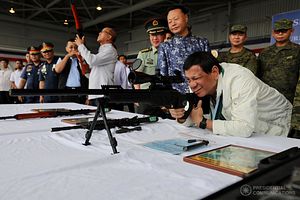On October 5, China delivered a second batch of arms to the Philippines in a handover ceremony attended by officials on both sides. The development was yet another sign of Beijing’s growing security ties with Manila, a longtime U.S. treaty ally, in spite of the challenges that still remain.
As I have noted previously, though the Philippines has traditionally not had much in the way of a defense relationship with China, Beijing’s deepening security ties with the Manila in the Duterte era has become a familiar story in recent months. Even though the progress has been much slower than the rhetoric might suggest, the fact is that we have seen forms of cooperation that were previously unthinkable, from closer coast guard cooperation to law enforcement assistance (See: “What’s Behind the New China-Philippines Coast Guard Exercise?”).
A key development came on June 28, when China delivered its first round of military assistance to Manila. As I noted then, Chinese Ambassador Zhao Jianhua presided over a high-profile ceremonial turnover at Clark Air Base in Pampanga attended by Duterte, with assistance worth 370 million pesos ($7.3 million) comprising around 3,000 rifles and 6 million pieces of ammunition (See: “The Truth About China’s New Military Aid to the Philippines”).
On October 5, Beijing delivered a second batch of equipment in a handover ceremony held in Camp Aguinaldo and attended by Zhao as well as Philippine defense officials including Defense Secretary Delfin Lorenzana and AFP Chief of Staff General Eduardo Ano. The assistance included 3,000 units of rifles, 3,000,000 rounds of assorted ammunition, and 30 sniper cones. Most of the rifles will be turned over to the Special Action Force (SAF) of the Philippine National Police (PNP), while the scopes will remain with the AFP.
In his remarks, Zhao cast the assistance as part of China’s firm support for the Philippines’ campaign against the terror threat posed by the Islamic State, which has been made clear by the battle being waged by the Philippine military against IS-linked militants in the southern city of Marawi since May (See: “Why Has the Philippines Struggled in its Terror Fight Under Duterte?”).
Though that assistance – which also includes other aid for the Marawi crisis more specifically – remains quite limited compared to that of Manila’s traditional partners like the United States, it is significant because, as Lorenzana himself noted, Philippine attempts to get these guns from the United States had earlier been complicated by concerns by Congress about human rights abuses.
China’s growing security role in the Philippines is a storyline that we will likely continue to see in the coming months. Zhao was keen to point out that the Chinese government was already preparing to transfer a third batch of military assistance to Manila. And China, Philippine defense officials say, has also been pushing for more robust forms of security cooperation that have yet to be realized.
Yet, as I have noted before, the limits of Sino-Philippine cooperation also need to be kept in mind, including the low level at which it is beginning relative to Manila’s traditional partners as well as lingering distrust by the two countries due to differences such as on the South China Sea (See: “Beware the New China-Philippines South China Sea Deal”).
It is also worth noting that after an initially rough start under Duterte, the outlook for U.S.-Philippine defense ties now looks more promising, contrary to the doomsday scenario that some in Beijing would like to paint about undermining American alliances in the region (See: “Recalibrating the US-Philippine Alliance in the Duterte Era”).
































